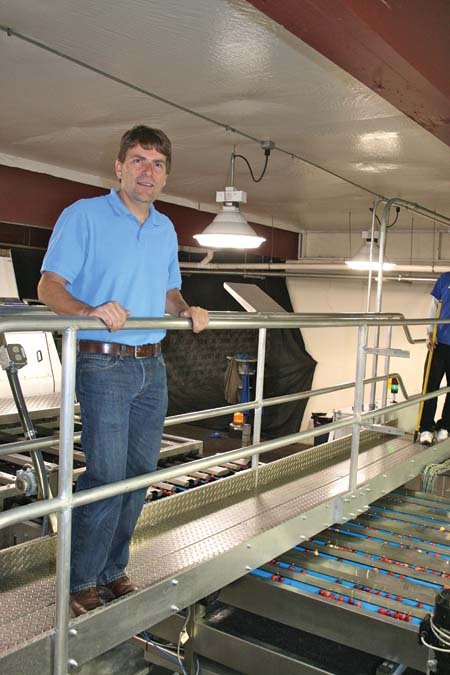New cherry sorters

Rick Lancaster said Chelan Fruit’s new cherry grader will help ensure that only firm cherries go to export markets.
Chelan Fruit Cooperative has about 600 year-round employees, but needs an additional 1,000 packing house workers during the cherry season. It installed a new cherry grader at its Brewster plant this season to reduce its labor needs.
After just a week of working with the new equipment, Rick Lancaster, Chelan Fruit’s director of operations, said it should, indeed, reduce the need for human sorters, but the ability to sort for internal defects, including softness, could create a new marketing dynamic.
The ten-lane electronic grader from GP Graders of Melbourne, Australia, uses vision technology from the Dutch company Ellips. It’s the same software used in the mobile apple harvest system developed by Picker Technologies.
Color can be sorted into any number of different grades, and the equipment can sort out external defects, such as limb rubs and cracking. It also uses near-infrared light to detect internal defects, such as bruising, cell-wall breakdown, and softness, said Stuart Payne, director of GP Graders. And it does this at a rate of 1,500 pounds per lane per hour.
Based on reducing the number of human sorters and processing more cherries, the payback period for the new grader was estimated to be three to four years.
The cooperative Blue Bird recently installed a similar four-lane grader at its Wenatchee plant. Eventually, Payne plans to begin manufacturing in Wenatchee.
Unitec Northern Fruit Company in East Wenatchee also upgraded its cherry line this season with new sorting equipment from Unitec in Spain. It is the first Unitec sorter in the United States, though there have been numerous Unitec installations in Chile.
Doug Pauly, operations manager, said the new Unitec line replaced an old Rainier line where limited color sorting or sizing could be done. The new line has optical sizing and has the capability of sorting for both external and internal defects.
“We hope it’s a little more efficient with labor, but the primary reason for installing it was the ability to separate by size and color,” Pauly said.
Bird control
A new formulation of an old bird-repellent chemical is being sold in its second season after receiving EPA registration late in 2010.
The active ingredient is methyl anthranilate, and it’s being sold under the name Avian Control by Avian Enterprises LLC, Sylvan Lake, Michigan. It is being used to protect fruit crops such as grapes, cherries, and blueberries, but is also used on grain crops, on golf courses, and in airports to reduce bird strikes with aircraft.
The bird-repelling properties of methyl anthranilate were discovered more than 50 years ago, but it was expensive to use because of its short residual life, according to Dan Kramer, technical director of Stone Soap Company, which manufactures Avian Control for its affiliated company. The new, patent pending, method of formulation gives it a residual life in an orchard of 10 to 14 days in the absence of heavy rain, he said.
The chemical is dispersible in water and can be applied with an airblast sprayer at 16 to 24 ounces per acre, at a cost of about $25 an acre at the higher rate, Kramer said. Sales have been “brisk,” he added.
Methyl anthranilate is not the first or only chemical repellent, but it is has one huge benefit that methiocarb (Mesurol) did not have: It is not poisonous. It is a food-grade chemical, generally regarded as safe (GRAS), that is used in food manufacturing to give the grape flavor to Kool-Aid. It’s also used for flavoring candy, soft drinks, gum, and other products. It occurs naturally in grapes and some other fruits.
The company is in the process of establishing a distribution network. To make direct contact, call (888) 707-4355 or go to www.solveyourbird problems.com.

Leave A Comment